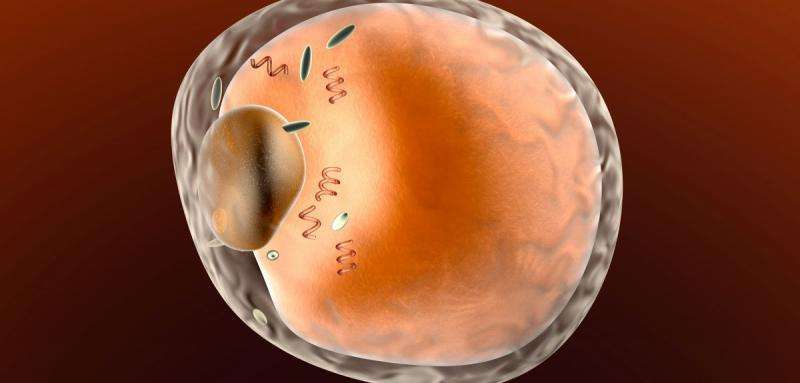Blocking obesity-associated protein stops dangerous fat formation

Visceral fat deposits around internal organs in the stomach are particularly harmful: they are associated with insulin resistance, type-2 diabetes and heart disease. The study, conducted in close collaboration with researchers at the at the French Institute of Health and Medical research (INSERM) in Paris, shows that changing the pattern of fat deposition from around the stomach to under the skin starts a chain of events which result in insulin sensitivity being maintained, reducing the chances of type-2 diabetes.
Researchers already know that visceral fat attracts special M1-type macrophages (immune cells that attack infections and damaged cells). These M1-type macrophages produce harmful proteins that promote insulin resistance. 'We've previously found that a protein called interferon regulatory factor-5 (IRF-5) seems to push macrophages to change from a more 'peaceful', M2-type to the more aggressive M1-type', said Professor Irina Udalova at the Kennedy Institute of Rheumatology at Oxford University, 'so we wondered if 'deleting' IRF-5 might have a beneficial effect'.
To test this idea, the two research teams fed the mice that were lacking the gene coding for IRF-5 with a healthy diet or a high-fat one. The mice with genetic changes were no different from standard lab mice when both the groups ate the healthy diet. Both groups of mice gained weight when they ate the high-fat diet. However, the mice with the altered gene piled on the fat under the skin, rather than around the internal organs in their stomach. The size of the fat cells in the stomach was also smaller in these mice, because there was more collagen (a 'scaffolding' protein that provides the structure for many parts of the body) deposits, holding the fat cells in.
'The mice without IRF-5 still got fat, but what was different was where they deposited this fat. We know that people who put on fat around their belly have a higher risk of developing obesity-related illnesses such as type-2 diabetes, compared to people who put on weight around their thighs. But we can't change the pattern of fat deposition in people, which we can now do in these mice. So this turned out to be an excellent way of testing if changing the pattern of fat deposition actually changes the factors that lead to type-2 diabetes', said Professor Udalova.
The researchers tested this idea by giving the mice a very sweet drink, containing glucose. They then tracked how quickly the glucose was broken down by insulin. Obesity can make the body less sensitive to insulin, which means that it takes longer for the glucose to disappear from the blood stream. This loss of sensitivity can eventually lead to type-2 diabetes. Despite being fatter, the mice without IRF-5 did better than the standard mice on this glucose challenge test.
Researchers at INSERM also found that IRF-5 levels were elevated in fatty tissue from very obese people, especially in their visceral fat. A gene analysis of this group of people found that the higher the levels of IRF-5, the lower the levels of another protein produced by macrophages, transforming growth factor beta (TGFbeta). By mimicking the environment in fatty tissue in a test-tube, the researchers also found that artificially increasing the levels of IRF-5 in cells from thin people reduced the levels of TGFbeta, similar to what was found in the obese people. The researchers think that reducing IRF-5 levels sets off a chain of events, starting with increased TGFbeta levels. Increased TGFbeta in turn leads to more collagen being deposited, which results in 'remodelling' of abdominal fat deposits, and the release of other chemicals that maintain insulin sensitivity.
'We found that the mice without IRF-5 were essentially healthy, despite being significantly fatter. Blocking IRF-5's activity may however have other side-effects, such as increasing allergies. So more work is needed to understand if changing levels of IRF-5 (by using new drugs to target the protein) in humans would be a good way of treating the problem of obesity and obesity associated metabolic diseases. But the results show very clearly that where you get fat matters a lot', said Professor Udalova.
More information: "Irf5 deficiency in macrophages promotes beneficial adipose tissue expansion and insulin sensitivity during obesity." Nature Medicine (2015) DOI: 10.1038/nm.3829



















